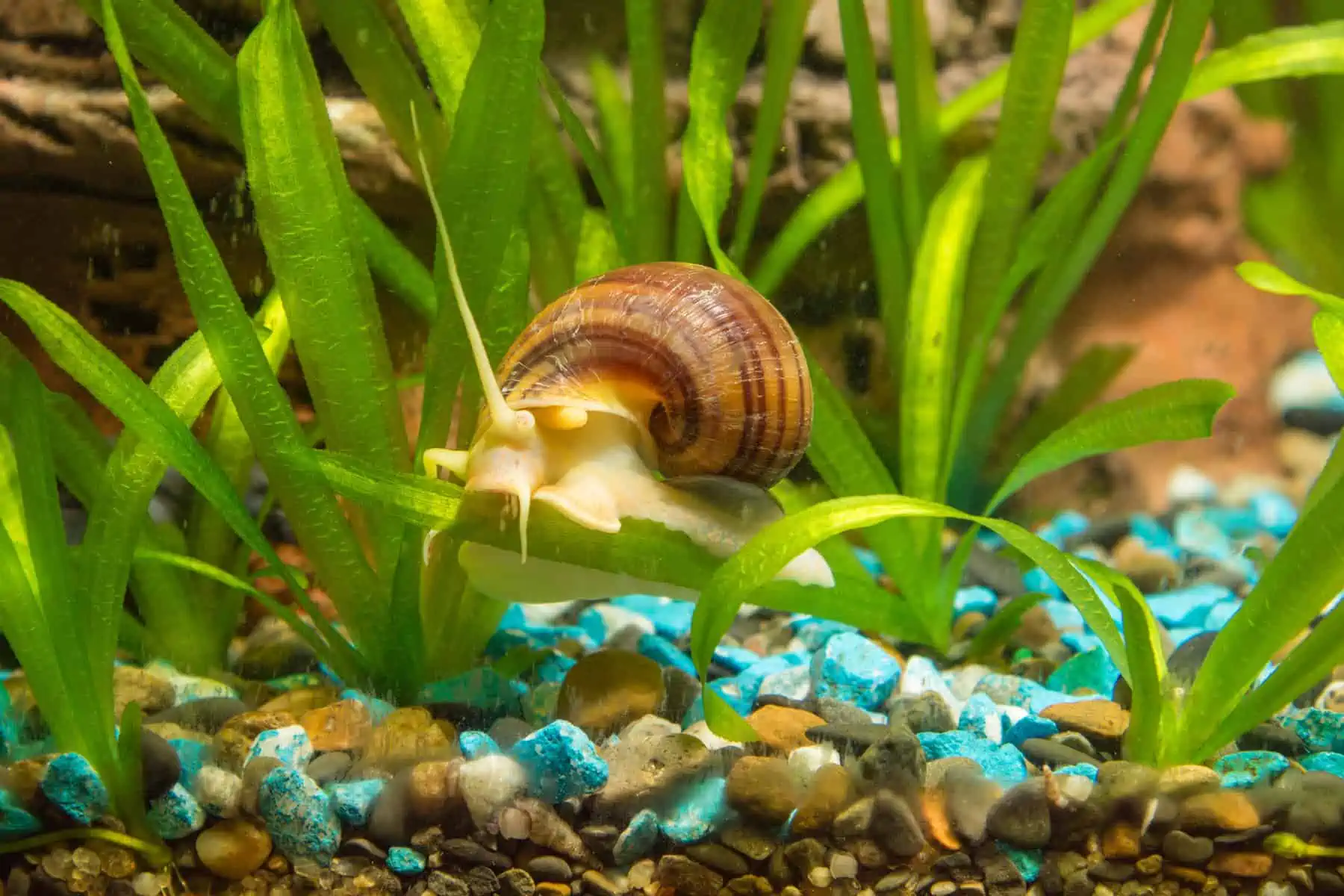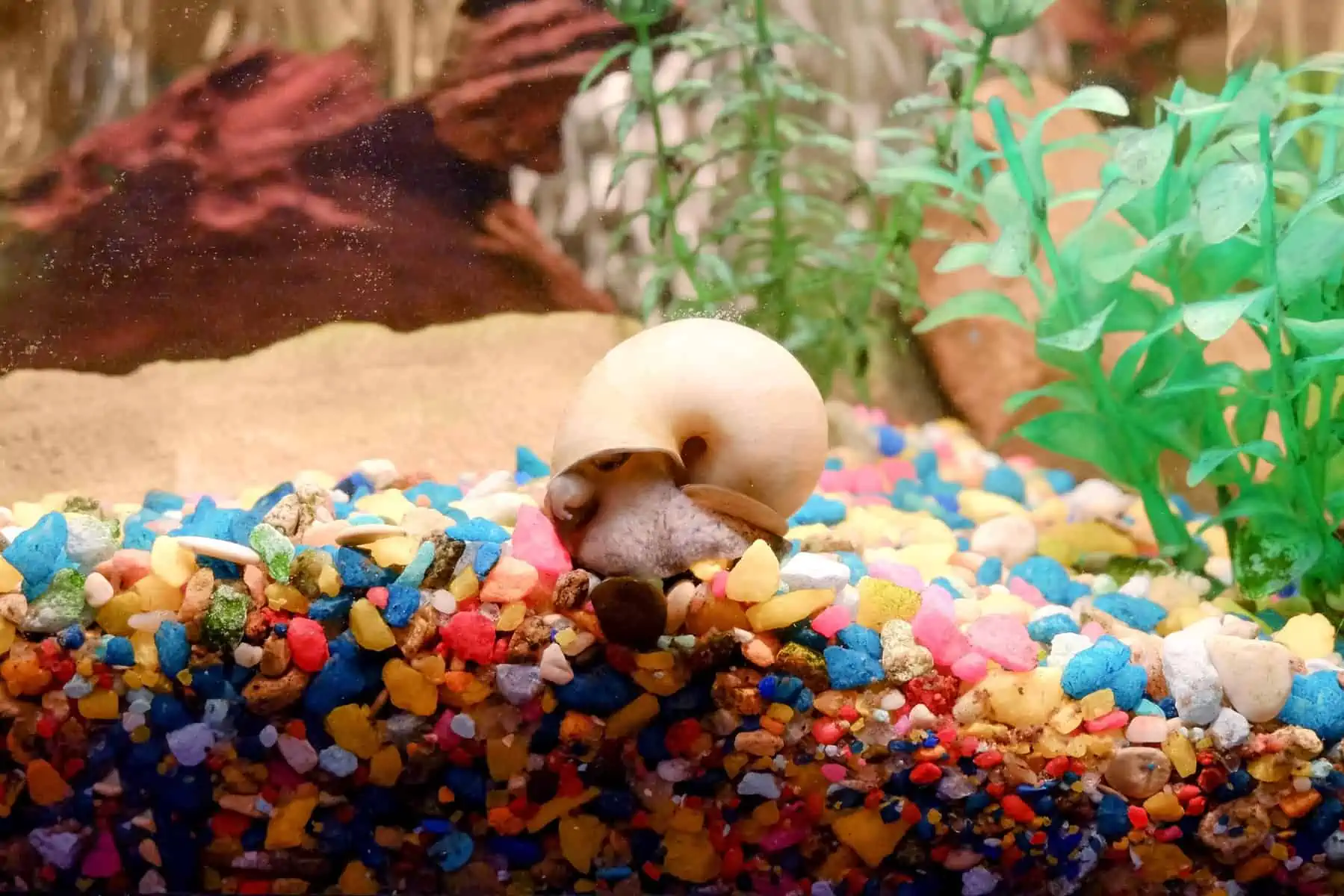Mystery snails need a fish tank filter to keep their water in good condition. Without a filter, levels of oxygen go down, levels of ammonia go up, and you can quickly have an unhealthy environment for your pet snails.
If you see your mystery snail floating for extended periods of time, breathing air from the surface, or trying to escape your tank, it may mean they’d benefit from better water quality.
Let’s take a closer look at the habits of this big, golden mollusk and why they need a filter.
First Of All, Who Is This Mysterious Mollusk?!
The mystery snail or spike-topped apple snail (pomacea bridgesii) is a subtropical-tropical freshwater snail native to South America.
They are relatively large snails, sometimes exceeding 2 inches in diameter. Their lovely yellow shells and cute, long-eye stalks have made them a big hit in the aquarium trade, especially in recent years.
They’re also fairly well-behaved snails that are very easy to keep, so you may be wondering…
Do Mystery Snails Need A Filter?
While in some circumstances mystery snails may be able to survive for a while without a filter, it is much better if they have one.
Aquarium filters perform so many important functions in the tank: they help to mix oxygen into the water for healthy respiration in animals, they help to mix carbon dioxide into the water for the healthy growth of plants, they turn toxic ammonia into safer nitrates, and they sieve tiny particles and toxic compounds from the water to keep the aquarium water safe and crystal clear.
All of these functions are important to mystery snails – let’s take a closer look at them, one at a time.
Mystery Snails Need Oxygen

There are many myths about how aquatic snails breathe, but much of this information has been pulled out of thin air! Most aquatic snails have comb-like gills for absorbing oxygen from the water, whereas a minority of aquatic snails need to come to the surface to breathe oxygen into their lungs, just like land snails do.
Mystery snails have quite complex breathing apparatus as they are born with both lungs and gills! They also possess a small tube used to breathe air from the surface called a siphon.
So while mystery snails are well-adapted to obtain some of their oxygen from the surface, it’s much better if they have adequate oxygen dissolved in the water too. A filter is very useful in keeping their water well-oxygenated.
Mystery Snails Like Plants & Plants Like CO2
The yellow shells of mystery snails look stunning, scrambling over the dark green forest of a densely planted aquascape. They’ll also enjoy live plants since the leaves offer them places to hide and surfaces to graze from.
Whereas other types of snails may like to nibble on live plant leaves, mystery snails are relatively well-behaved and will tend to only eat plant leaves that are already dying – a stellar cleaning service!
The even better news is that aquatic plants can also benefit from sharing a tank with mystery snails! Mystery snails are brilliant at cleaning layers of algae and biofilm from plant leaves, meaning the plants can receive more light and therefore photosynthesize more effectively.
But since plants need a constant supply of CO2 to thrive, they’ll need a filter to produce bubbles or agitate the water so that enough carbon dioxide gets dissolved into the water.
Ammonia Is Toxic to Aquatic Snails
We all know that even small quantities of ammonia can be lethal to fish, but is ammonia toxic to aquarium snails?
Research conducted by the United States Environmental Protection Agency ( USEPA) reveals that freshwater, gill-breathing snails are relatively sensitive to ammonia toxicity.
Further investigations revealed that as a protective response, these types of snails tend to turn themselves upside down and float to the surface when exposed to toxic concentrations of ammonia.
Perhaps this adaptation is designed to allow them to float away to purer waters. They right themselves again and return to normal behavior only when ammonia levels have returned to safe levels.
Since mystery snails are partly gill-breathing, they are also likely to exhibit these types of responses to ammonia in the aquarium. They may also try to escape your aquarium if water conditions don’t suit them, so always keep a tight lid on your tank to be on the safe side!
Without a biological filter, ammonia is likely to build up to dangerous levels – yet another good reason to have a filter for mystery snails!
You’ll Need A Filter For The Snail’s Tankmates!
Even if you think that mystery snails are tough enough to survive without a filter in their own snail tank, this certainly won’t be the case with any other creatures you’d like to keep them with!
Snails are probably the most tolerant of any aquatic pet when it comes to water quality, but most people will want to keep some other species of fish or invertebrates with their snails too. Snails are ideal tank mates after all!
But all species of fish and shrimps need a filter to remain healthy. Even betta fish and guppies that some people have tried to keep without a filter will tend to die at an early age if kept without one.
Do Baby Mystery Snails Need A Filter?
Mystery snails are famous for their prolific breeding habits. Unlike nerite snails which are unable to reproduce in freshwater, mystery snails can multiply themselves at an alarming rate in a freshwater fish tank.
Some people like to raise baby mystery snails in a separate tank to protect them from fish predation, but do you need a filter in the breeding tank?
If you want the majority of your baby snails to survive, we’d definitely recommend a filter for a snail breeding tank. A mother mystery snail can lay up to 300 eggs, so that’s a lot of extra snail respiration and snail waste to deal with!
Extra supplies of oxygen and filtration are recommended, along with frequent partial water changes.
Can Mystery Snails Live In A Fishbowl?

Mystery snails belong to the apple snail family – so-called because some of the members can grow to the size of small apples!
These large snails need plenty of space. Most people recommend keeping no more than two mystery snails per 5 gallons of water. If you have a 5-gallon fish bowl with a low-powered sponge filter, you could keep two mystery snails to add interest and help keep the bowl clean.
What Else Do Mystery Snails Need In Their Tank?
Along with a filter, mystery snails will enjoy a substrate such as gravel or sand for them to crawl around on. Some rocks and live plants will also provide them with hiding places and better oxygenation.
Mystery snails don’t strictly need a heater as they are happy in a wide range of temperatures – between 68-82 Fahrenheit. This means that as long as your tank is in a fairly warm room, there’s no necessity for additional heating – just keep an eye on the water temperature with a reliable thermometer.
Do Nerite Snails Need A Filter or Heater?
The popular, striped nerite snail is more warm-loving than the mystery snail and needs a heater to keep the water between 72-80 Fahrenheit. Just like mystery snails, they will also appreciate a filter.
This makes nerite snails excellent companions to tropical freshwater fish as they share similar requirements.
Conclusion
Mystery snails are easy-to-keep pets for aquariums but need a filter to keep the tank clean and provide them with a good source of oxygen.
Keeping them without a filter may lead to ammonia poisoning or your snails trying to escape your tank! Keep a close eye on your snails, keep a tight-fitting lid for your fish tank, and most importantly, keep a good quality filter in good condition for the best chances of success in keeping these famous freshwater snails.


